The Microsoft Surface Laptop 3 Showdown: AMD's Ryzen Picasso vs. Intel's Ice Lake
by Brett Howse & Andrei Frumusanu on December 13, 2019 8:30 AM ESTSystem Performance
Moving on from SPEC to some of our more traditional laptop tests, I’ve taken the opportunity to add some new tests to the suite, which we’ll include on all laptops going forward. While SPEC is a fantastic set of tests to probe the limits of a platform, not everyone is going to run a workload that runs at nearly 100% CPU utilization for such a long time on a laptop. The 8-Thread tests took 4.5 hours to complete on Ice Lake, and 6.5 hours to complete on Picasso, which is likely not something most people would turn to a thin and light laptop for, so it’s important to see how both platforms perform on shorter tests where they can leverage their peak boost frequencies for a higher percentage of the duration.
PCMark 10
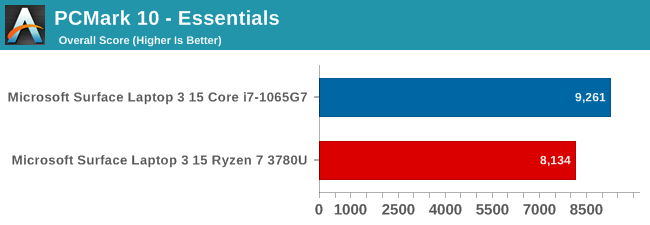

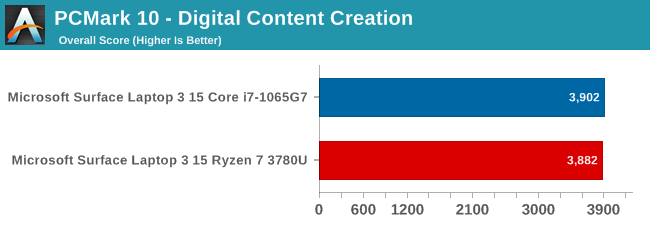
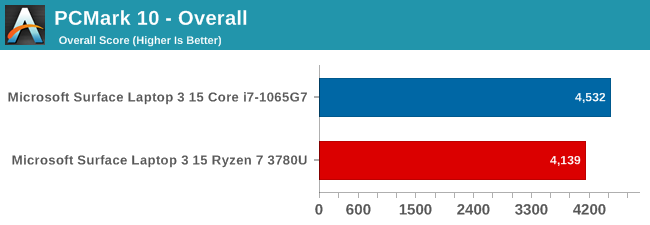
PCMark 10 consists of several real-world tests, including web, video conferencing, spreadsheets, writing, and more. There are several GPU tests as well, including rendering, and some gaming. The suite also measures application start-up, and all aspects of the system’s performance factor into the score.
Intel’s CPU performance lead shows clearly here again, with significant leads in both the Essentials and Productivity tests, although AMD’s strong GPU pulls the Ryzen system very close on the Digital Content Creation tasks. But that is not enough to turn the tide, and the Ice Lake platform carries this win.
Cinebench R20
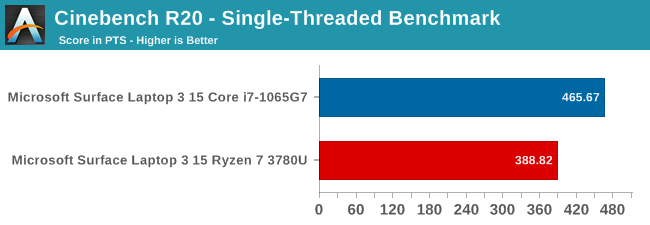
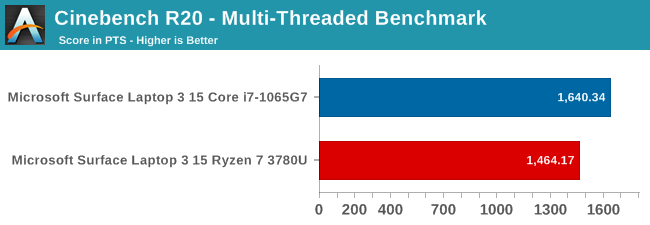
Looking at the latest version of Cinebench tells a similar story as to what we’ve seen so far. Ice Lake’s significant IPC lead pulls it way ahead. On the multi-threaded test, the AMD platform does close the gap somewhat, which is similar to the SPEC rate 8 results.
7-Zip
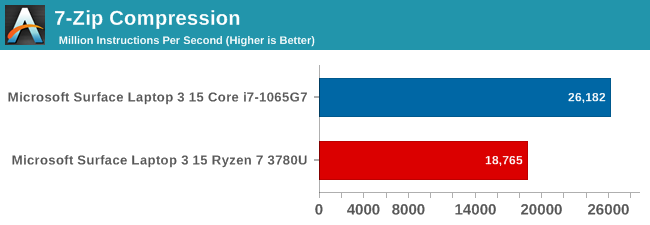
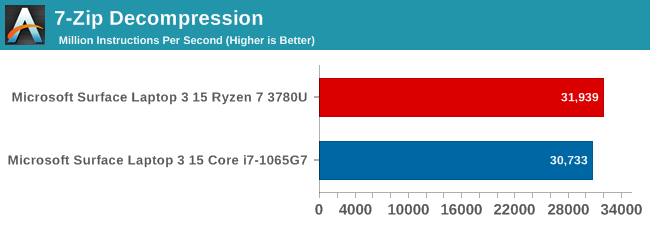
Checking out the popular 7-Zip file compression tool, the results are in-line with what we see in the desktop space. Intel generally has a lead on the compression side, but AMD claws back at decompression. It is a rare win on the CPU side for AMD here.
Handbrake
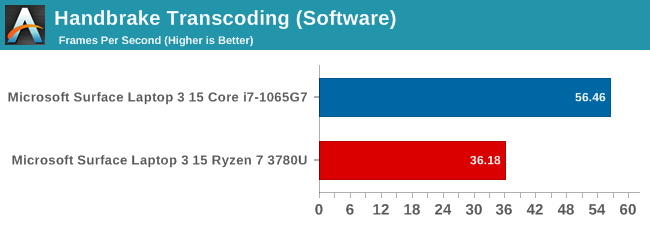
Transcoding is a popular task, and Handbrake is one of the most popular tools. For this test, a 1080p movie is converted to 720p using the x264 encoder. Once again, Ice Lake offers significantly more performance when transcoding in software.

Handbrake also supports various hardware encoders, such as Intel’s QuickSync, which provides significantly quicker transcodes at the same settings – albeit at larger file sizes and slightly lower quality compared to the software transcode, according to the Handbrake documentation. QuickSync has been very popular, and has been around quite a while. AMD also offers hardware encoding and decoding with their Video Core Next platform. Handbrake does support AMD’s Video Coding Engine (VCE) but the Surface Laptop 3 does not offer this as an option in Handbrake, so it was not able to be tested. As this is the only current Ryzen mobile APU we’ve tested, it may be a driver issue specific to the Surface branded processor.
x264
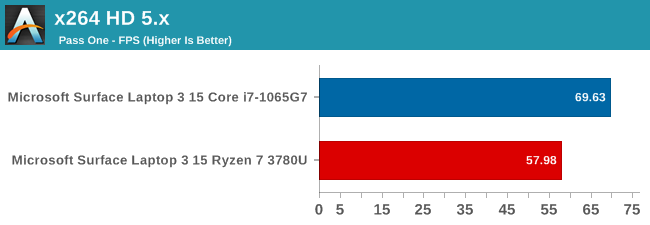
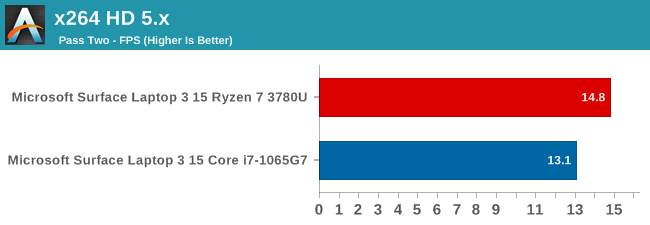
Our previous transcoding test, x264, was also run. Here we see that once again Ice Lake has a significant performance advantage, as it did with Handbrake software encoding.
Web Tests
All of our web tests were run with the current version of Microsoft Edge in Windows 10 1909. Web results are highly impacted by the underlying scripting engine, and Microsoft is going to be moving Edge from the EdgeHTML rendering engine to the Chromium open-source project that powers Google Chrome. When they make this change, expected early in 2020, we’ll revamp our suite with new tests.
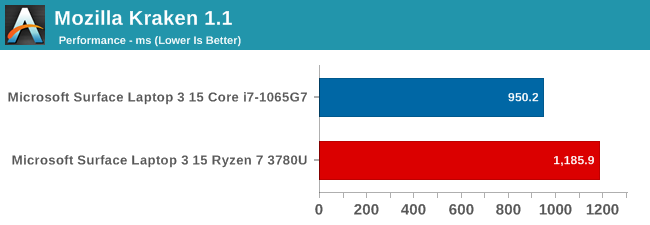

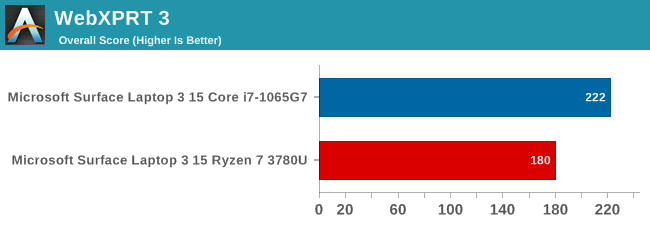
Intel has aggressively pushed their frequency ramping with Speed Shift, and one of the biggest beneficiaries of Speed Shift is web scripting, since the tasks tend to be very short. AMD is addressing this in Zen 2 with Collaborative Power Performance Control 2, or CPPC2, which is not as elegant of a name as Speed Shift, but promises to drop Zen’s frequency ramping from ~30 ms to ~1 to 2 ms, and will be a welcome addition on our web tests.










174 Comments
View All Comments
Zoolook - Saturday, December 21, 2019 - link
LP memory uses half size channels compared to regular DDR among other things, if you haven't designed your controller for it, it won't work, and since LP memory has only been used in the mobile sector earlier there was no reason for AMD to design the controller with that in mind.Extra transistors that could be used better elsewhere.
RSAUser - Friday, December 13, 2019 - link
Remember this is Zen gen 1, when they still had the RAM frequency scaling issue vs infinity fabric.sorten - Friday, December 13, 2019 - link
Whoa, nice surprise for a Friday morning! Thanks for the review.Results are about what I expected, and I guess this was the risk for AMD pushing out their previous gen APU for a high profile product. I hope they get the Zen 2 APUs into products soon.
coder543 - Friday, December 13, 2019 - link
Microsoft really should have waited until mobile Zen 2.sing_electric - Friday, December 13, 2019 - link
Honestly, I have no earthly clue why MS makes most of the choices it does with its hardware products. They launched the Surface Studio with a Maxwell GPU right after Pascal came out... then waited 2 years until after Turing was out to update the machine with the Pascal GPUs they should have had at launch. For a machine that is theoretically for "creators" (though, let's be honest, is probably mostly found on the desk of the boss of whoever is actually doing the creating).They did the same thing with the ARM-based Surface Pro X with a custom chip based on the already-year-old Qualcomm 8cx. Honestly, the bigger surprise is that the updated Surface Pro series actually uses current-gen Intel chips soon after they launched.
tipoo - Thursday, December 19, 2019 - link
Bet the Studio 3 comes out right before Ampere too. I agree, sometimes it seems like they're deliberately making themselves a bit less appealing not to piss off their partners.TheinsanegamerN - Friday, December 13, 2019 - link
And miss all the holiday sales?Here is the issue: AMD's mantra is "wait until X", but when "X" arrives, it is outclassed by the competition, or comes out after the major holiday season. The rest of the world doesnt run on AMD's schedule, and this only hurts AMD. If MS didnt want to use zen+, the consumer model would have simply gone with ice lake.
Zen 2 APUs should have come out when the rest of zen 2 did.
Meteor2 - Friday, December 13, 2019 - link
For sure, but they don't have the money to do the development concurrently. Something had to give.lmcd - Friday, December 13, 2019 - link
More like they don't have the money to hold CPU releases for GPU integrationChiplet arch should fix this and let AMD integrate within the same cycle -- this should, in theory, be the last cycle or second-to-last cycle where AMD ships a previous-generation "APU."
RSAUser - Friday, December 13, 2019 - link
Don't think it was the money for mobile Zen 2, more likely lack of available wafers from TSMC, rather supply Desktop as enthusiast and gamers will then market the product while cashing in profits from Epyc.